Nestle: Business Environment Analysis - Organizational Performance
VerifiedAdded on 2020/01/07
|16
|4838
|68
Report
AI Summary
This report provides an in-depth analysis of Nestle's business environment, examining its organizational purposes, the impact of national and global factors, and its market environment. The report begins by identifying the purposes of different types of organizations, particularly focusing on Nestle as a private entity, and assesses how Nestle meets the objectives of various stakeholders, including shareholders, employees, customers, environmental groups, and agencies. It then explores the responsibilities of the organization and the strategies employed to meet them, considering ethical issues, consumer legislations, fair trade practices, and sustainable business codes. The analysis extends to the nature of the national environment, discussing how economic systems allocate resources, and assessing the impact of fiscal and monetary policies. The report also examines market structures, market forces, and the influence of business and cultural environments on Nestle's behavior. Finally, it assesses the significance of global factors, including international trade and the impact of the European Union's policies on Nestle's business operations, concluding with a summary of the key findings.
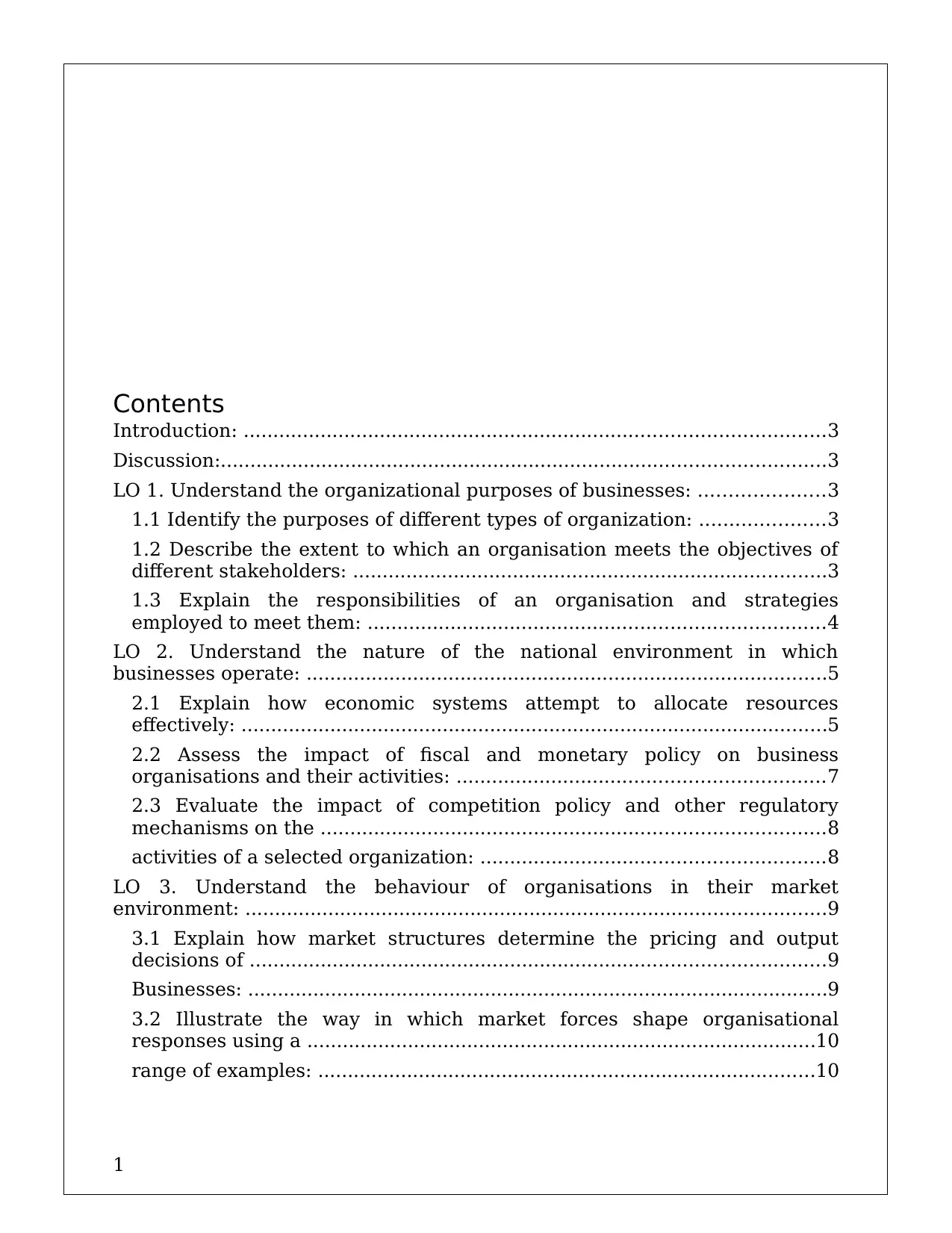
Contents
Introduction: ..................................................................................................3
Discussion:......................................................................................................3
LO 1. Understand the organizational purposes of businesses: .....................3
1.1 Identify the purposes of different types of organization: .....................3
1.2 Describe the extent to which an organisation meets the objectives of
different stakeholders: ................................................................................3
1.3 Explain the responsibilities of an organisation and strategies
employed to meet them: .............................................................................4
LO 2. Understand the nature of the national environment in which
businesses operate: ........................................................................................5
2.1 Explain how economic systems attempt to allocate resources
effectively: ...................................................................................................5
2.2 Assess the impact of fiscal and monetary policy on business
organisations and their activities: ..............................................................7
2.3 Evaluate the impact of competition policy and other regulatory
mechanisms on the .....................................................................................8
activities of a selected organization: ..........................................................8
LO 3. Understand the behaviour of organisations in their market
environment: ..................................................................................................9
3.1 Explain how market structures determine the pricing and output
decisions of .................................................................................................9
Businesses: ..................................................................................................9
3.2 Illustrate the way in which market forces shape organisational
responses using a ......................................................................................10
range of examples: ....................................................................................10
1
Introduction: ..................................................................................................3
Discussion:......................................................................................................3
LO 1. Understand the organizational purposes of businesses: .....................3
1.1 Identify the purposes of different types of organization: .....................3
1.2 Describe the extent to which an organisation meets the objectives of
different stakeholders: ................................................................................3
1.3 Explain the responsibilities of an organisation and strategies
employed to meet them: .............................................................................4
LO 2. Understand the nature of the national environment in which
businesses operate: ........................................................................................5
2.1 Explain how economic systems attempt to allocate resources
effectively: ...................................................................................................5
2.2 Assess the impact of fiscal and monetary policy on business
organisations and their activities: ..............................................................7
2.3 Evaluate the impact of competition policy and other regulatory
mechanisms on the .....................................................................................8
activities of a selected organization: ..........................................................8
LO 3. Understand the behaviour of organisations in their market
environment: ..................................................................................................9
3.1 Explain how market structures determine the pricing and output
decisions of .................................................................................................9
Businesses: ..................................................................................................9
3.2 Illustrate the way in which market forces shape organisational
responses using a ......................................................................................10
range of examples: ....................................................................................10
1
Paraphrase This Document
Need a fresh take? Get an instant paraphrase of this document with our AI Paraphraser
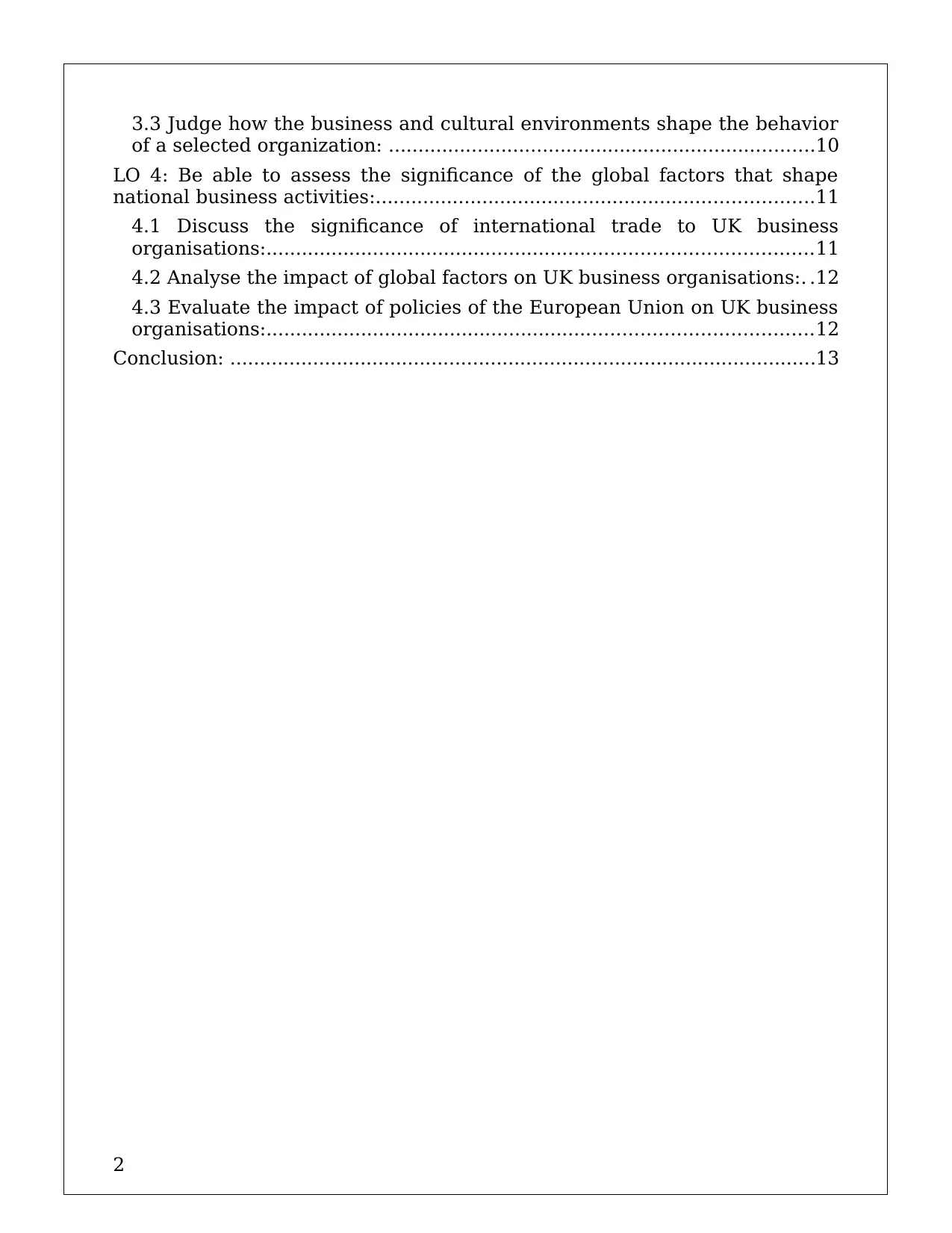
3.3 Judge how the business and cultural environments shape the behavior
of a selected organization: ........................................................................10
LO 4: Be able to assess the significance of the global factors that shape
national business activities:..........................................................................11
4.1 Discuss the significance of international trade to UK business
organisations:............................................................................................11
4.2 Analyse the impact of global factors on UK business organisations:. .12
4.3 Evaluate the impact of policies of the European Union on UK business
organisations:............................................................................................12
Conclusion: ...................................................................................................13
2
of a selected organization: ........................................................................10
LO 4: Be able to assess the significance of the global factors that shape
national business activities:..........................................................................11
4.1 Discuss the significance of international trade to UK business
organisations:............................................................................................11
4.2 Analyse the impact of global factors on UK business organisations:. .12
4.3 Evaluate the impact of policies of the European Union on UK business
organisations:............................................................................................12
Conclusion: ...................................................................................................13
2
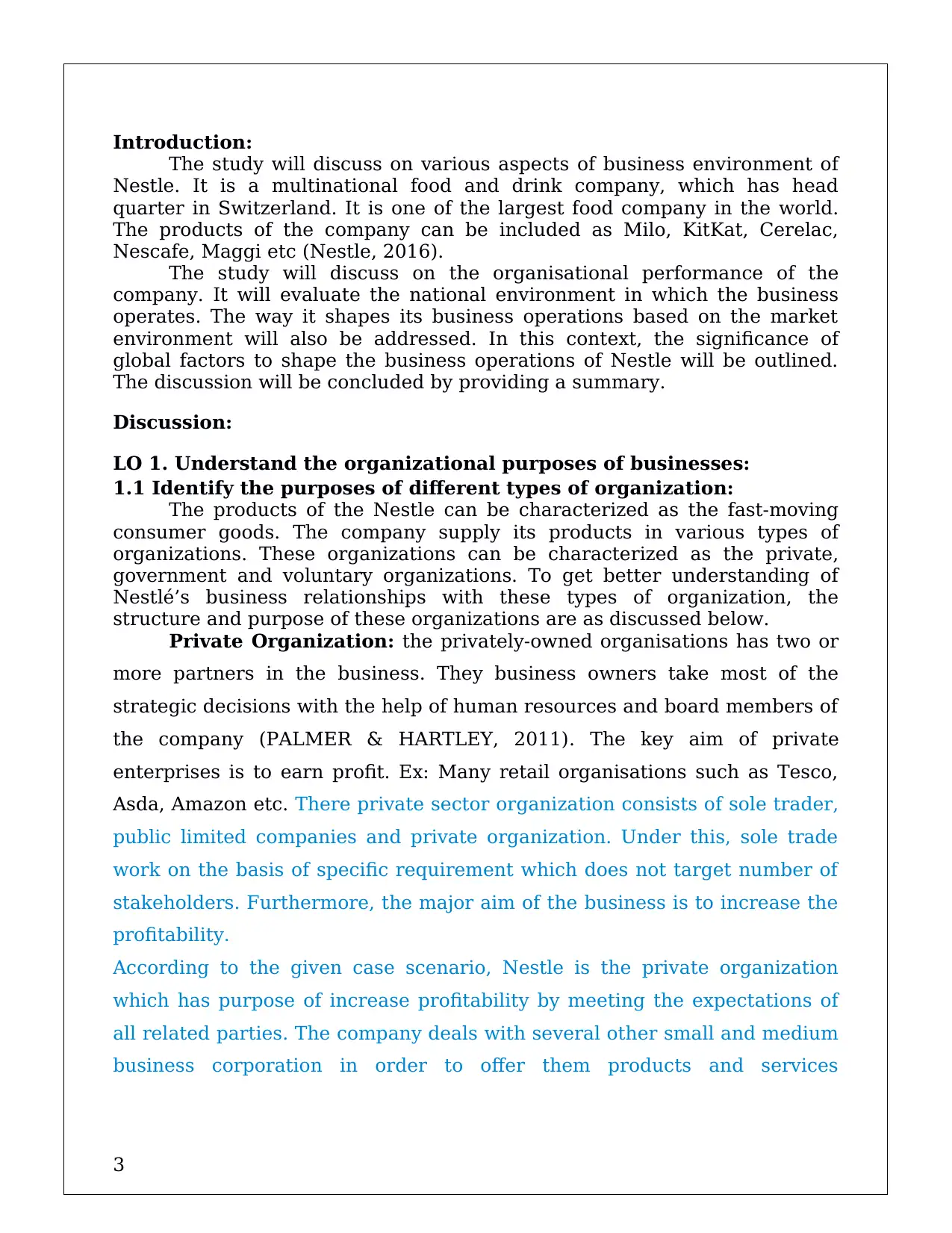
Introduction:
The study will discuss on various aspects of business environment of
Nestle. It is a multinational food and drink company, which has head
quarter in Switzerland. It is one of the largest food company in the world.
The products of the company can be included as Milo, KitKat, Cerelac,
Nescafe, Maggi etc (Nestle, 2016).
The study will discuss on the organisational performance of the
company. It will evaluate the national environment in which the business
operates. The way it shapes its business operations based on the market
environment will also be addressed. In this context, the significance of
global factors to shape the business operations of Nestle will be outlined.
The discussion will be concluded by providing a summary.
Discussion:
LO 1. Understand the organizational purposes of businesses:
1.1 Identify the purposes of different types of organization:
The products of the Nestle can be characterized as the fast-moving
consumer goods. The company supply its products in various types of
organizations. These organizations can be characterized as the private,
government and voluntary organizations. To get better understanding of
Nestlé’s business relationships with these types of organization, the
structure and purpose of these organizations are as discussed below.
Private Organization: the privately-owned organisations has two or
more partners in the business. They business owners take most of the
strategic decisions with the help of human resources and board members of
the company (PALMER & HARTLEY, 2011). The key aim of private
enterprises is to earn profit. Ex: Many retail organisations such as Tesco,
Asda, Amazon etc. There private sector organization consists of sole trader,
public limited companies and private organization. Under this, sole trade
work on the basis of specific requirement which does not target number of
stakeholders. Furthermore, the major aim of the business is to increase the
profitability.
According to the given case scenario, Nestle is the private organization
which has purpose of increase profitability by meeting the expectations of
all related parties. The company deals with several other small and medium
business corporation in order to offer them products and services
3
The study will discuss on various aspects of business environment of
Nestle. It is a multinational food and drink company, which has head
quarter in Switzerland. It is one of the largest food company in the world.
The products of the company can be included as Milo, KitKat, Cerelac,
Nescafe, Maggi etc (Nestle, 2016).
The study will discuss on the organisational performance of the
company. It will evaluate the national environment in which the business
operates. The way it shapes its business operations based on the market
environment will also be addressed. In this context, the significance of
global factors to shape the business operations of Nestle will be outlined.
The discussion will be concluded by providing a summary.
Discussion:
LO 1. Understand the organizational purposes of businesses:
1.1 Identify the purposes of different types of organization:
The products of the Nestle can be characterized as the fast-moving
consumer goods. The company supply its products in various types of
organizations. These organizations can be characterized as the private,
government and voluntary organizations. To get better understanding of
Nestlé’s business relationships with these types of organization, the
structure and purpose of these organizations are as discussed below.
Private Organization: the privately-owned organisations has two or
more partners in the business. They business owners take most of the
strategic decisions with the help of human resources and board members of
the company (PALMER & HARTLEY, 2011). The key aim of private
enterprises is to earn profit. Ex: Many retail organisations such as Tesco,
Asda, Amazon etc. There private sector organization consists of sole trader,
public limited companies and private organization. Under this, sole trade
work on the basis of specific requirement which does not target number of
stakeholders. Furthermore, the major aim of the business is to increase the
profitability.
According to the given case scenario, Nestle is the private organization
which has purpose of increase profitability by meeting the expectations of
all related parties. The company deals with several other small and medium
business corporation in order to offer them products and services
3
⊘ This is a preview!⊘
Do you want full access?
Subscribe today to unlock all pages.

Trusted by 1+ million students worldwide
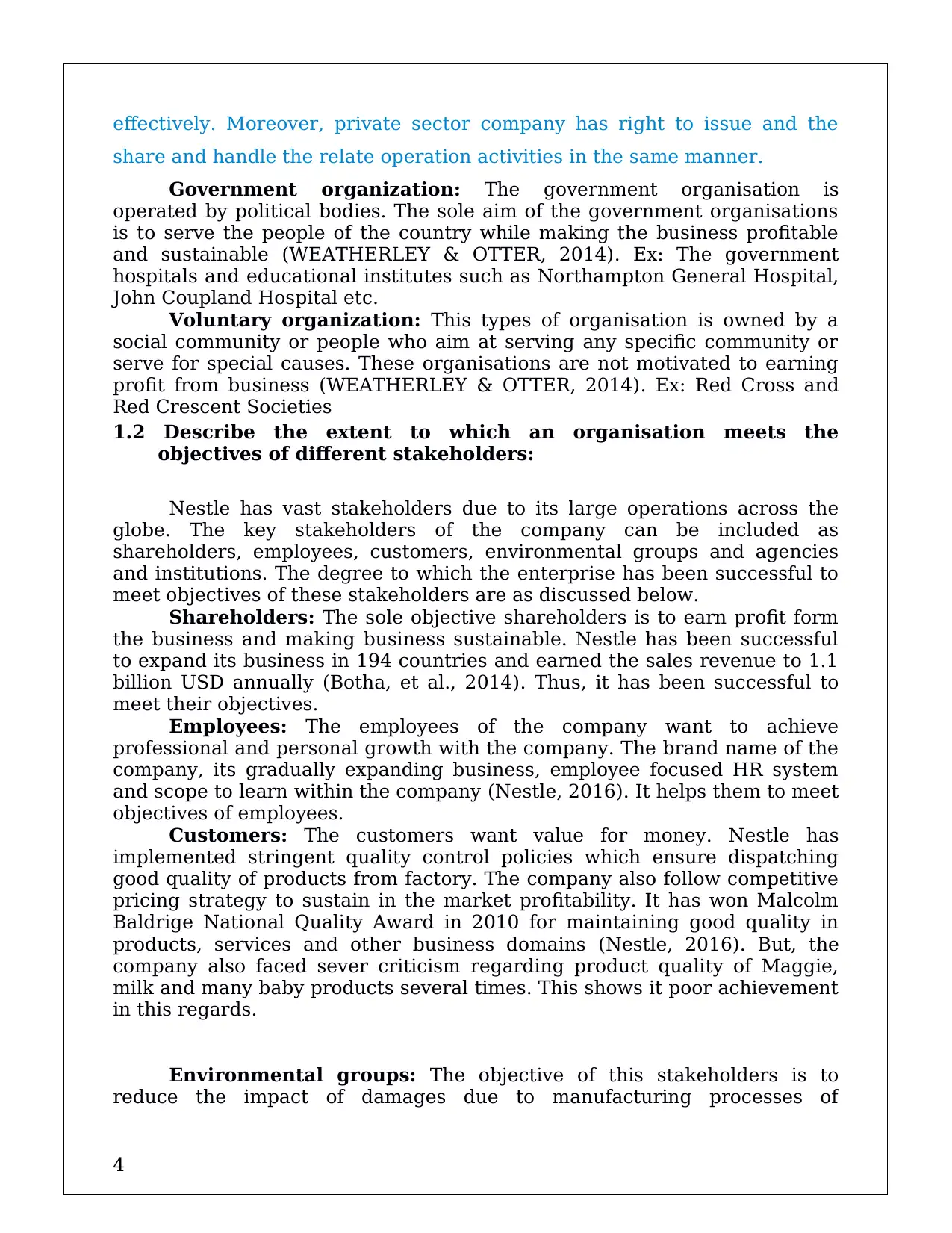
effectively. Moreover, private sector company has right to issue and the
share and handle the relate operation activities in the same manner.
Government organization: The government organisation is
operated by political bodies. The sole aim of the government organisations
is to serve the people of the country while making the business profitable
and sustainable (WEATHERLEY & OTTER, 2014). Ex: The government
hospitals and educational institutes such as Northampton General Hospital,
John Coupland Hospital etc.
Voluntary organization: This types of organisation is owned by a
social community or people who aim at serving any specific community or
serve for special causes. These organisations are not motivated to earning
profit from business (WEATHERLEY & OTTER, 2014). Ex: Red Cross and
Red Crescent Societies
1.2 Describe the extent to which an organisation meets the
objectives of different stakeholders:
Nestle has vast stakeholders due to its large operations across the
globe. The key stakeholders of the company can be included as
shareholders, employees, customers, environmental groups and agencies
and institutions. The degree to which the enterprise has been successful to
meet objectives of these stakeholders are as discussed below.
Shareholders: The sole objective shareholders is to earn profit form
the business and making business sustainable. Nestle has been successful
to expand its business in 194 countries and earned the sales revenue to 1.1
billion USD annually (Botha, et al., 2014). Thus, it has been successful to
meet their objectives.
Employees: The employees of the company want to achieve
professional and personal growth with the company. The brand name of the
company, its gradually expanding business, employee focused HR system
and scope to learn within the company (Nestle, 2016). It helps them to meet
objectives of employees.
Customers: The customers want value for money. Nestle has
implemented stringent quality control policies which ensure dispatching
good quality of products from factory. The company also follow competitive
pricing strategy to sustain in the market profitability. It has won Malcolm
Baldrige National Quality Award in 2010 for maintaining good quality in
products, services and other business domains (Nestle, 2016). But, the
company also faced sever criticism regarding product quality of Maggie,
milk and many baby products several times. This shows it poor achievement
in this regards.
Environmental groups: The objective of this stakeholders is to
reduce the impact of damages due to manufacturing processes of
4
share and handle the relate operation activities in the same manner.
Government organization: The government organisation is
operated by political bodies. The sole aim of the government organisations
is to serve the people of the country while making the business profitable
and sustainable (WEATHERLEY & OTTER, 2014). Ex: The government
hospitals and educational institutes such as Northampton General Hospital,
John Coupland Hospital etc.
Voluntary organization: This types of organisation is owned by a
social community or people who aim at serving any specific community or
serve for special causes. These organisations are not motivated to earning
profit from business (WEATHERLEY & OTTER, 2014). Ex: Red Cross and
Red Crescent Societies
1.2 Describe the extent to which an organisation meets the
objectives of different stakeholders:
Nestle has vast stakeholders due to its large operations across the
globe. The key stakeholders of the company can be included as
shareholders, employees, customers, environmental groups and agencies
and institutions. The degree to which the enterprise has been successful to
meet objectives of these stakeholders are as discussed below.
Shareholders: The sole objective shareholders is to earn profit form
the business and making business sustainable. Nestle has been successful
to expand its business in 194 countries and earned the sales revenue to 1.1
billion USD annually (Botha, et al., 2014). Thus, it has been successful to
meet their objectives.
Employees: The employees of the company want to achieve
professional and personal growth with the company. The brand name of the
company, its gradually expanding business, employee focused HR system
and scope to learn within the company (Nestle, 2016). It helps them to meet
objectives of employees.
Customers: The customers want value for money. Nestle has
implemented stringent quality control policies which ensure dispatching
good quality of products from factory. The company also follow competitive
pricing strategy to sustain in the market profitability. It has won Malcolm
Baldrige National Quality Award in 2010 for maintaining good quality in
products, services and other business domains (Nestle, 2016). But, the
company also faced sever criticism regarding product quality of Maggie,
milk and many baby products several times. This shows it poor achievement
in this regards.
Environmental groups: The objective of this stakeholders is to
reduce the impact of damages due to manufacturing processes of
4
Paraphrase This Document
Need a fresh take? Get an instant paraphrase of this document with our AI Paraphraser
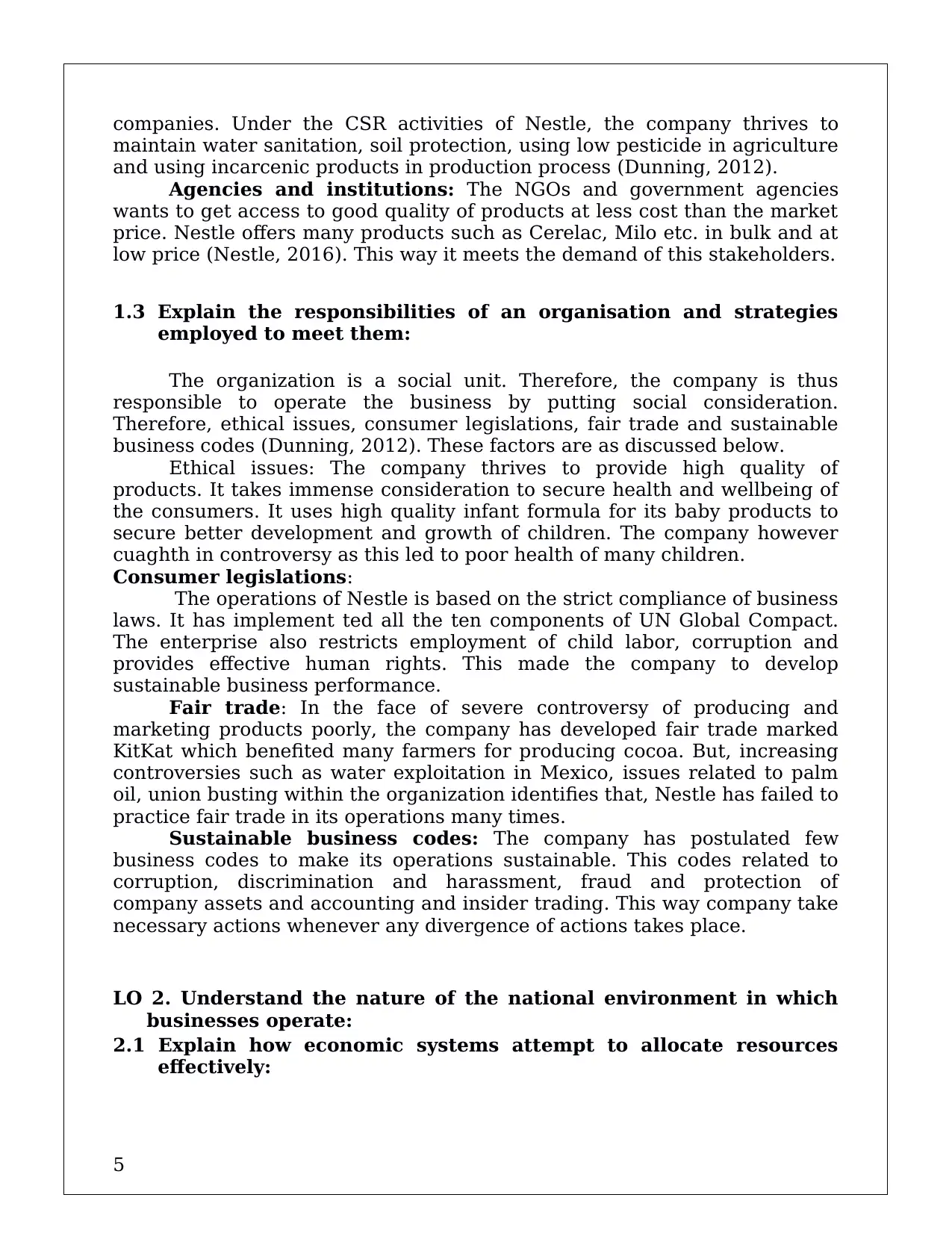
companies. Under the CSR activities of Nestle, the company thrives to
maintain water sanitation, soil protection, using low pesticide in agriculture
and using incarcenic products in production process (Dunning, 2012).
Agencies and institutions: The NGOs and government agencies
wants to get access to good quality of products at less cost than the market
price. Nestle offers many products such as Cerelac, Milo etc. in bulk and at
low price (Nestle, 2016). This way it meets the demand of this stakeholders.
1.3 Explain the responsibilities of an organisation and strategies
employed to meet them:
The organization is a social unit. Therefore, the company is thus
responsible to operate the business by putting social consideration.
Therefore, ethical issues, consumer legislations, fair trade and sustainable
business codes (Dunning, 2012). These factors are as discussed below.
Ethical issues: The company thrives to provide high quality of
products. It takes immense consideration to secure health and wellbeing of
the consumers. It uses high quality infant formula for its baby products to
secure better development and growth of children. The company however
cuaghth in controversy as this led to poor health of many children.
Consumer legislations:
The operations of Nestle is based on the strict compliance of business
laws. It has implement ted all the ten components of UN Global Compact.
The enterprise also restricts employment of child labor, corruption and
provides effective human rights. This made the company to develop
sustainable business performance.
Fair trade: In the face of severe controversy of producing and
marketing products poorly, the company has developed fair trade marked
KitKat which benefited many farmers for producing cocoa. But, increasing
controversies such as water exploitation in Mexico, issues related to palm
oil, union busting within the organization identifies that, Nestle has failed to
practice fair trade in its operations many times.
Sustainable business codes: The company has postulated few
business codes to make its operations sustainable. This codes related to
corruption, discrimination and harassment, fraud and protection of
company assets and accounting and insider trading. This way company take
necessary actions whenever any divergence of actions takes place.
LO 2. Understand the nature of the national environment in which
businesses operate:
2.1 Explain how economic systems attempt to allocate resources
effectively:
5
maintain water sanitation, soil protection, using low pesticide in agriculture
and using incarcenic products in production process (Dunning, 2012).
Agencies and institutions: The NGOs and government agencies
wants to get access to good quality of products at less cost than the market
price. Nestle offers many products such as Cerelac, Milo etc. in bulk and at
low price (Nestle, 2016). This way it meets the demand of this stakeholders.
1.3 Explain the responsibilities of an organisation and strategies
employed to meet them:
The organization is a social unit. Therefore, the company is thus
responsible to operate the business by putting social consideration.
Therefore, ethical issues, consumer legislations, fair trade and sustainable
business codes (Dunning, 2012). These factors are as discussed below.
Ethical issues: The company thrives to provide high quality of
products. It takes immense consideration to secure health and wellbeing of
the consumers. It uses high quality infant formula for its baby products to
secure better development and growth of children. The company however
cuaghth in controversy as this led to poor health of many children.
Consumer legislations:
The operations of Nestle is based on the strict compliance of business
laws. It has implement ted all the ten components of UN Global Compact.
The enterprise also restricts employment of child labor, corruption and
provides effective human rights. This made the company to develop
sustainable business performance.
Fair trade: In the face of severe controversy of producing and
marketing products poorly, the company has developed fair trade marked
KitKat which benefited many farmers for producing cocoa. But, increasing
controversies such as water exploitation in Mexico, issues related to palm
oil, union busting within the organization identifies that, Nestle has failed to
practice fair trade in its operations many times.
Sustainable business codes: The company has postulated few
business codes to make its operations sustainable. This codes related to
corruption, discrimination and harassment, fraud and protection of
company assets and accounting and insider trading. This way company take
necessary actions whenever any divergence of actions takes place.
LO 2. Understand the nature of the national environment in which
businesses operate:
2.1 Explain how economic systems attempt to allocate resources
effectively:
5
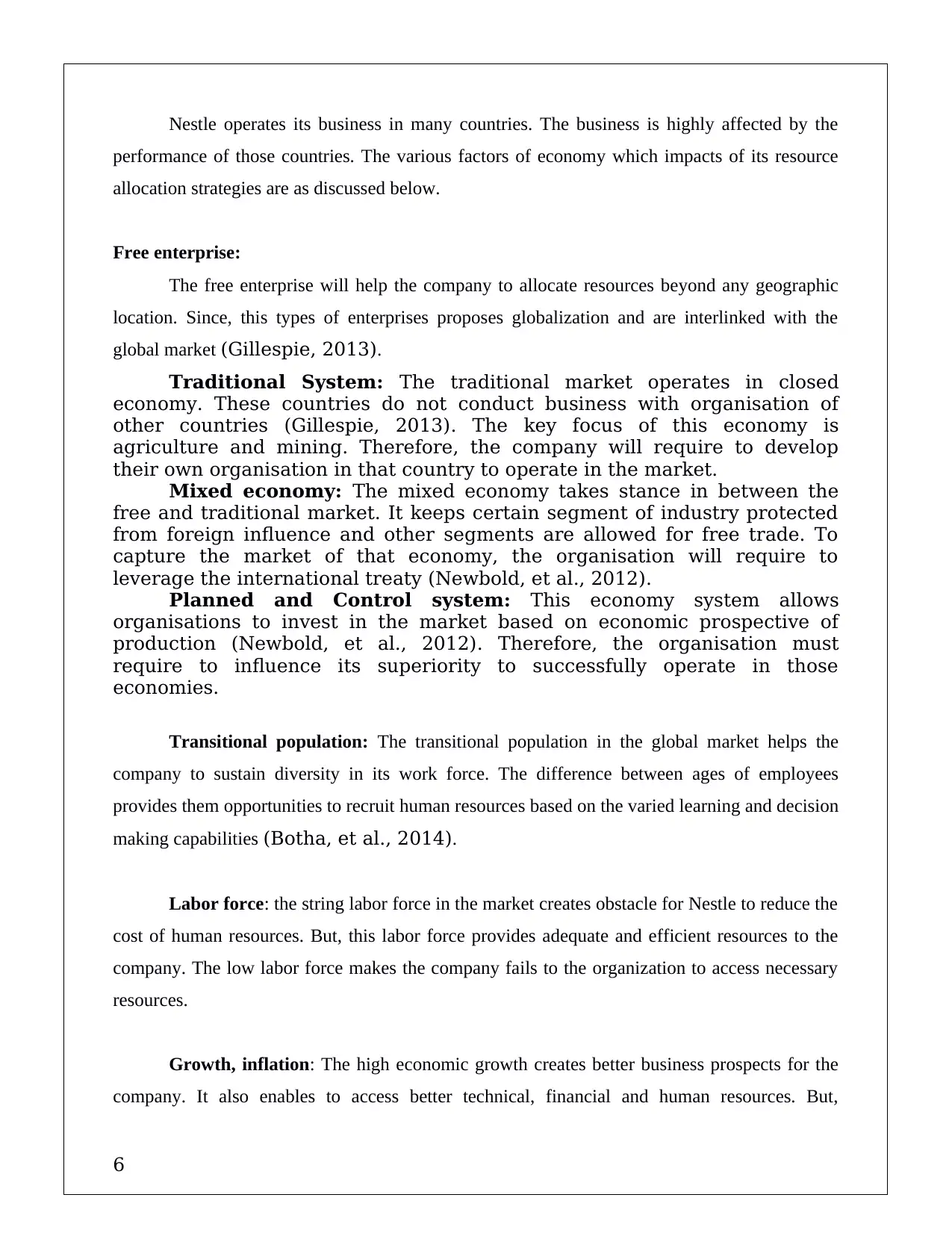
Nestle operates its business in many countries. The business is highly affected by the
performance of those countries. The various factors of economy which impacts of its resource
allocation strategies are as discussed below.
Free enterprise:
The free enterprise will help the company to allocate resources beyond any geographic
location. Since, this types of enterprises proposes globalization and are interlinked with the
global market (Gillespie, 2013).
Traditional System: The traditional market operates in closed
economy. These countries do not conduct business with organisation of
other countries (Gillespie, 2013). The key focus of this economy is
agriculture and mining. Therefore, the company will require to develop
their own organisation in that country to operate in the market.
Mixed economy: The mixed economy takes stance in between the
free and traditional market. It keeps certain segment of industry protected
from foreign influence and other segments are allowed for free trade. To
capture the market of that economy, the organisation will require to
leverage the international treaty (Newbold, et al., 2012).
Planned and Control system: This economy system allows
organisations to invest in the market based on economic prospective of
production (Newbold, et al., 2012). Therefore, the organisation must
require to influence its superiority to successfully operate in those
economies.
Transitional population: The transitional population in the global market helps the
company to sustain diversity in its work force. The difference between ages of employees
provides them opportunities to recruit human resources based on the varied learning and decision
making capabilities (Botha, et al., 2014).
Labor force: the string labor force in the market creates obstacle for Nestle to reduce the
cost of human resources. But, this labor force provides adequate and efficient resources to the
company. The low labor force makes the company fails to the organization to access necessary
resources.
Growth, inflation: The high economic growth creates better business prospects for the
company. It also enables to access better technical, financial and human resources. But,
6
performance of those countries. The various factors of economy which impacts of its resource
allocation strategies are as discussed below.
Free enterprise:
The free enterprise will help the company to allocate resources beyond any geographic
location. Since, this types of enterprises proposes globalization and are interlinked with the
global market (Gillespie, 2013).
Traditional System: The traditional market operates in closed
economy. These countries do not conduct business with organisation of
other countries (Gillespie, 2013). The key focus of this economy is
agriculture and mining. Therefore, the company will require to develop
their own organisation in that country to operate in the market.
Mixed economy: The mixed economy takes stance in between the
free and traditional market. It keeps certain segment of industry protected
from foreign influence and other segments are allowed for free trade. To
capture the market of that economy, the organisation will require to
leverage the international treaty (Newbold, et al., 2012).
Planned and Control system: This economy system allows
organisations to invest in the market based on economic prospective of
production (Newbold, et al., 2012). Therefore, the organisation must
require to influence its superiority to successfully operate in those
economies.
Transitional population: The transitional population in the global market helps the
company to sustain diversity in its work force. The difference between ages of employees
provides them opportunities to recruit human resources based on the varied learning and decision
making capabilities (Botha, et al., 2014).
Labor force: the string labor force in the market creates obstacle for Nestle to reduce the
cost of human resources. But, this labor force provides adequate and efficient resources to the
company. The low labor force makes the company fails to the organization to access necessary
resources.
Growth, inflation: The high economic growth creates better business prospects for the
company. It also enables to access better technical, financial and human resources. But,
6
⊘ This is a preview!⊘
Do you want full access?
Subscribe today to unlock all pages.

Trusted by 1+ million students worldwide
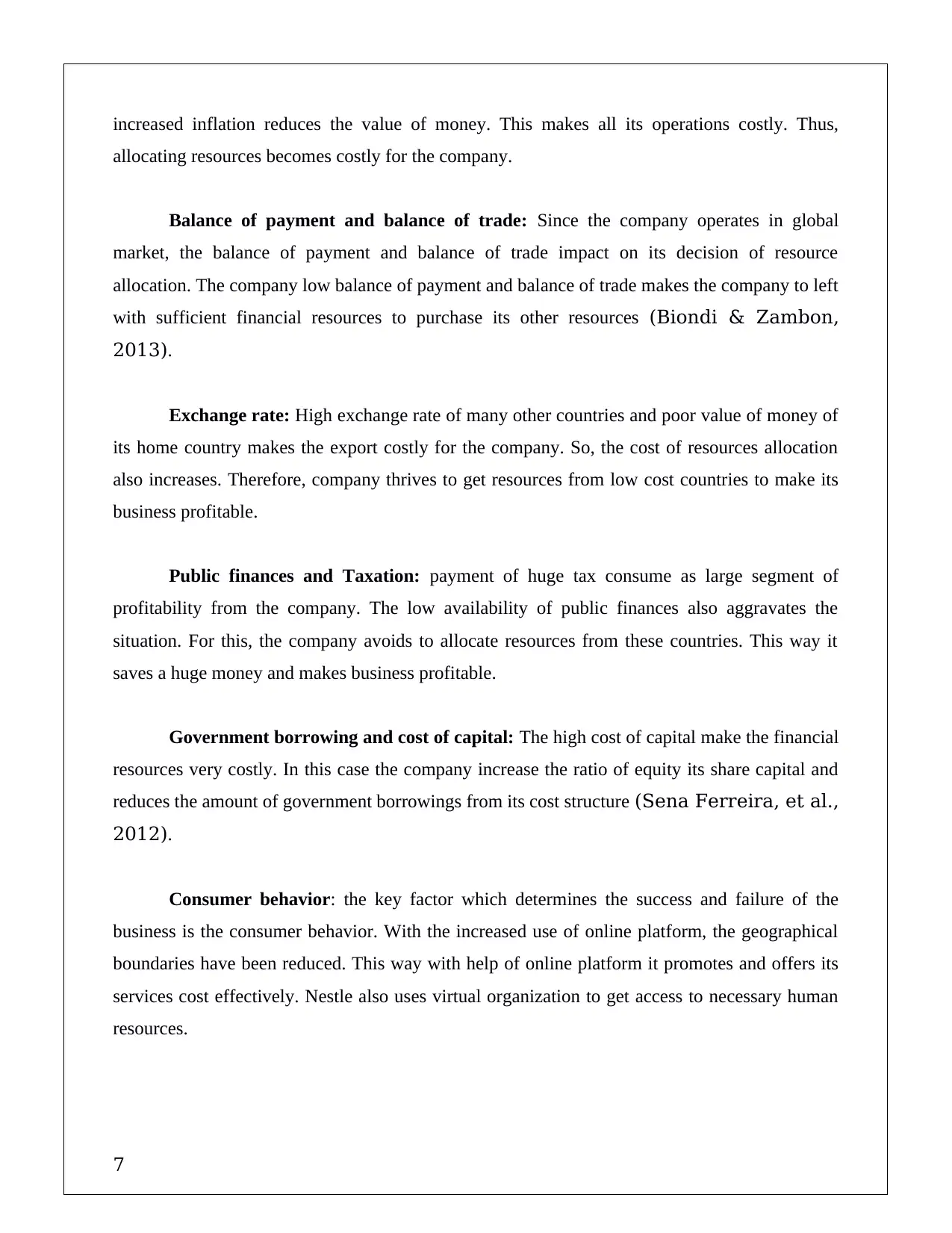
increased inflation reduces the value of money. This makes all its operations costly. Thus,
allocating resources becomes costly for the company.
Balance of payment and balance of trade: Since the company operates in global
market, the balance of payment and balance of trade impact on its decision of resource
allocation. The company low balance of payment and balance of trade makes the company to left
with sufficient financial resources to purchase its other resources (Biondi & Zambon,
2013).
Exchange rate: High exchange rate of many other countries and poor value of money of
its home country makes the export costly for the company. So, the cost of resources allocation
also increases. Therefore, company thrives to get resources from low cost countries to make its
business profitable.
Public finances and Taxation: payment of huge tax consume as large segment of
profitability from the company. The low availability of public finances also aggravates the
situation. For this, the company avoids to allocate resources from these countries. This way it
saves a huge money and makes business profitable.
Government borrowing and cost of capital: The high cost of capital make the financial
resources very costly. In this case the company increase the ratio of equity its share capital and
reduces the amount of government borrowings from its cost structure (Sena Ferreira, et al.,
2012).
Consumer behavior: the key factor which determines the success and failure of the
business is the consumer behavior. With the increased use of online platform, the geographical
boundaries have been reduced. This way with help of online platform it promotes and offers its
services cost effectively. Nestle also uses virtual organization to get access to necessary human
resources.
7
allocating resources becomes costly for the company.
Balance of payment and balance of trade: Since the company operates in global
market, the balance of payment and balance of trade impact on its decision of resource
allocation. The company low balance of payment and balance of trade makes the company to left
with sufficient financial resources to purchase its other resources (Biondi & Zambon,
2013).
Exchange rate: High exchange rate of many other countries and poor value of money of
its home country makes the export costly for the company. So, the cost of resources allocation
also increases. Therefore, company thrives to get resources from low cost countries to make its
business profitable.
Public finances and Taxation: payment of huge tax consume as large segment of
profitability from the company. The low availability of public finances also aggravates the
situation. For this, the company avoids to allocate resources from these countries. This way it
saves a huge money and makes business profitable.
Government borrowing and cost of capital: The high cost of capital make the financial
resources very costly. In this case the company increase the ratio of equity its share capital and
reduces the amount of government borrowings from its cost structure (Sena Ferreira, et al.,
2012).
Consumer behavior: the key factor which determines the success and failure of the
business is the consumer behavior. With the increased use of online platform, the geographical
boundaries have been reduced. This way with help of online platform it promotes and offers its
services cost effectively. Nestle also uses virtual organization to get access to necessary human
resources.
7
Paraphrase This Document
Need a fresh take? Get an instant paraphrase of this document with our AI Paraphraser
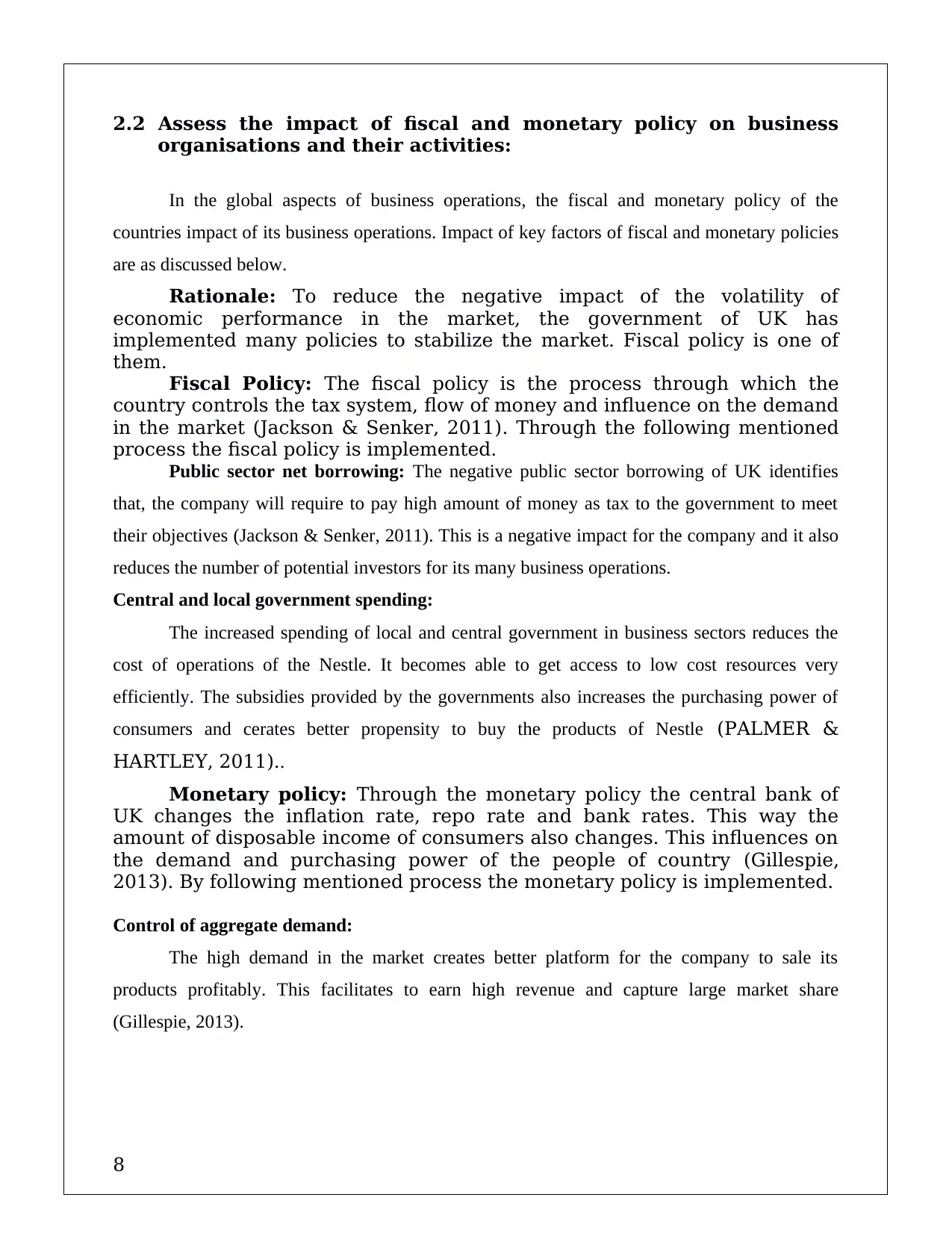
2.2 Assess the impact of fiscal and monetary policy on business
organisations and their activities:
In the global aspects of business operations, the fiscal and monetary policy of the
countries impact of its business operations. Impact of key factors of fiscal and monetary policies
are as discussed below.
Rationale: To reduce the negative impact of the volatility of
economic performance in the market, the government of UK has
implemented many policies to stabilize the market. Fiscal policy is one of
them.
Fiscal Policy: The fiscal policy is the process through which the
country controls the tax system, flow of money and influence on the demand
in the market (Jackson & Senker, 2011). Through the following mentioned
process the fiscal policy is implemented.
Public sector net borrowing: The negative public sector borrowing of UK identifies
that, the company will require to pay high amount of money as tax to the government to meet
their objectives (Jackson & Senker, 2011). This is a negative impact for the company and it also
reduces the number of potential investors for its many business operations.
Central and local government spending:
The increased spending of local and central government in business sectors reduces the
cost of operations of the Nestle. It becomes able to get access to low cost resources very
efficiently. The subsidies provided by the governments also increases the purchasing power of
consumers and cerates better propensity to buy the products of Nestle (PALMER &
HARTLEY, 2011)..
Monetary policy: Through the monetary policy the central bank of
UK changes the inflation rate, repo rate and bank rates. This way the
amount of disposable income of consumers also changes. This influences on
the demand and purchasing power of the people of country (Gillespie,
2013). By following mentioned process the monetary policy is implemented.
Control of aggregate demand:
The high demand in the market creates better platform for the company to sale its
products profitably. This facilitates to earn high revenue and capture large market share
(Gillespie, 2013).
8
organisations and their activities:
In the global aspects of business operations, the fiscal and monetary policy of the
countries impact of its business operations. Impact of key factors of fiscal and monetary policies
are as discussed below.
Rationale: To reduce the negative impact of the volatility of
economic performance in the market, the government of UK has
implemented many policies to stabilize the market. Fiscal policy is one of
them.
Fiscal Policy: The fiscal policy is the process through which the
country controls the tax system, flow of money and influence on the demand
in the market (Jackson & Senker, 2011). Through the following mentioned
process the fiscal policy is implemented.
Public sector net borrowing: The negative public sector borrowing of UK identifies
that, the company will require to pay high amount of money as tax to the government to meet
their objectives (Jackson & Senker, 2011). This is a negative impact for the company and it also
reduces the number of potential investors for its many business operations.
Central and local government spending:
The increased spending of local and central government in business sectors reduces the
cost of operations of the Nestle. It becomes able to get access to low cost resources very
efficiently. The subsidies provided by the governments also increases the purchasing power of
consumers and cerates better propensity to buy the products of Nestle (PALMER &
HARTLEY, 2011)..
Monetary policy: Through the monetary policy the central bank of
UK changes the inflation rate, repo rate and bank rates. This way the
amount of disposable income of consumers also changes. This influences on
the demand and purchasing power of the people of country (Gillespie,
2013). By following mentioned process the monetary policy is implemented.
Control of aggregate demand:
The high demand in the market creates better platform for the company to sale its
products profitably. This facilitates to earn high revenue and capture large market share
(Gillespie, 2013).
8
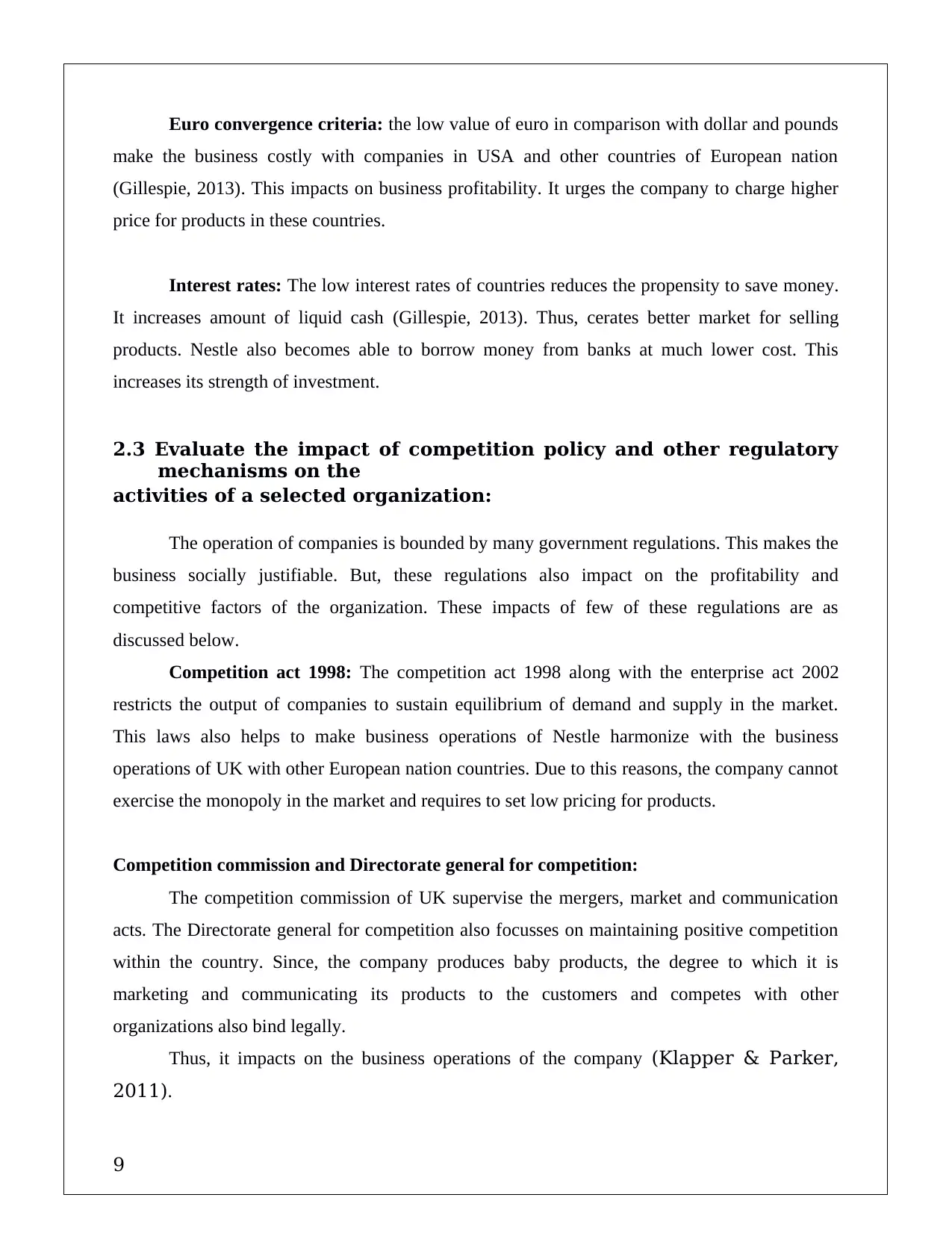
Euro convergence criteria: the low value of euro in comparison with dollar and pounds
make the business costly with companies in USA and other countries of European nation
(Gillespie, 2013). This impacts on business profitability. It urges the company to charge higher
price for products in these countries.
Interest rates: The low interest rates of countries reduces the propensity to save money.
It increases amount of liquid cash (Gillespie, 2013). Thus, cerates better market for selling
products. Nestle also becomes able to borrow money from banks at much lower cost. This
increases its strength of investment.
2.3 Evaluate the impact of competition policy and other regulatory
mechanisms on the
activities of a selected organization:
The operation of companies is bounded by many government regulations. This makes the
business socially justifiable. But, these regulations also impact on the profitability and
competitive factors of the organization. These impacts of few of these regulations are as
discussed below.
Competition act 1998: The competition act 1998 along with the enterprise act 2002
restricts the output of companies to sustain equilibrium of demand and supply in the market.
This laws also helps to make business operations of Nestle harmonize with the business
operations of UK with other European nation countries. Due to this reasons, the company cannot
exercise the monopoly in the market and requires to set low pricing for products.
Competition commission and Directorate general for competition:
The competition commission of UK supervise the mergers, market and communication
acts. The Directorate general for competition also focusses on maintaining positive competition
within the country. Since, the company produces baby products, the degree to which it is
marketing and communicating its products to the customers and competes with other
organizations also bind legally.
Thus, it impacts on the business operations of the company (Klapper & Parker,
2011).
9
make the business costly with companies in USA and other countries of European nation
(Gillespie, 2013). This impacts on business profitability. It urges the company to charge higher
price for products in these countries.
Interest rates: The low interest rates of countries reduces the propensity to save money.
It increases amount of liquid cash (Gillespie, 2013). Thus, cerates better market for selling
products. Nestle also becomes able to borrow money from banks at much lower cost. This
increases its strength of investment.
2.3 Evaluate the impact of competition policy and other regulatory
mechanisms on the
activities of a selected organization:
The operation of companies is bounded by many government regulations. This makes the
business socially justifiable. But, these regulations also impact on the profitability and
competitive factors of the organization. These impacts of few of these regulations are as
discussed below.
Competition act 1998: The competition act 1998 along with the enterprise act 2002
restricts the output of companies to sustain equilibrium of demand and supply in the market.
This laws also helps to make business operations of Nestle harmonize with the business
operations of UK with other European nation countries. Due to this reasons, the company cannot
exercise the monopoly in the market and requires to set low pricing for products.
Competition commission and Directorate general for competition:
The competition commission of UK supervise the mergers, market and communication
acts. The Directorate general for competition also focusses on maintaining positive competition
within the country. Since, the company produces baby products, the degree to which it is
marketing and communicating its products to the customers and competes with other
organizations also bind legally.
Thus, it impacts on the business operations of the company (Klapper & Parker,
2011).
9
⊘ This is a preview!⊘
Do you want full access?
Subscribe today to unlock all pages.

Trusted by 1+ million students worldwide
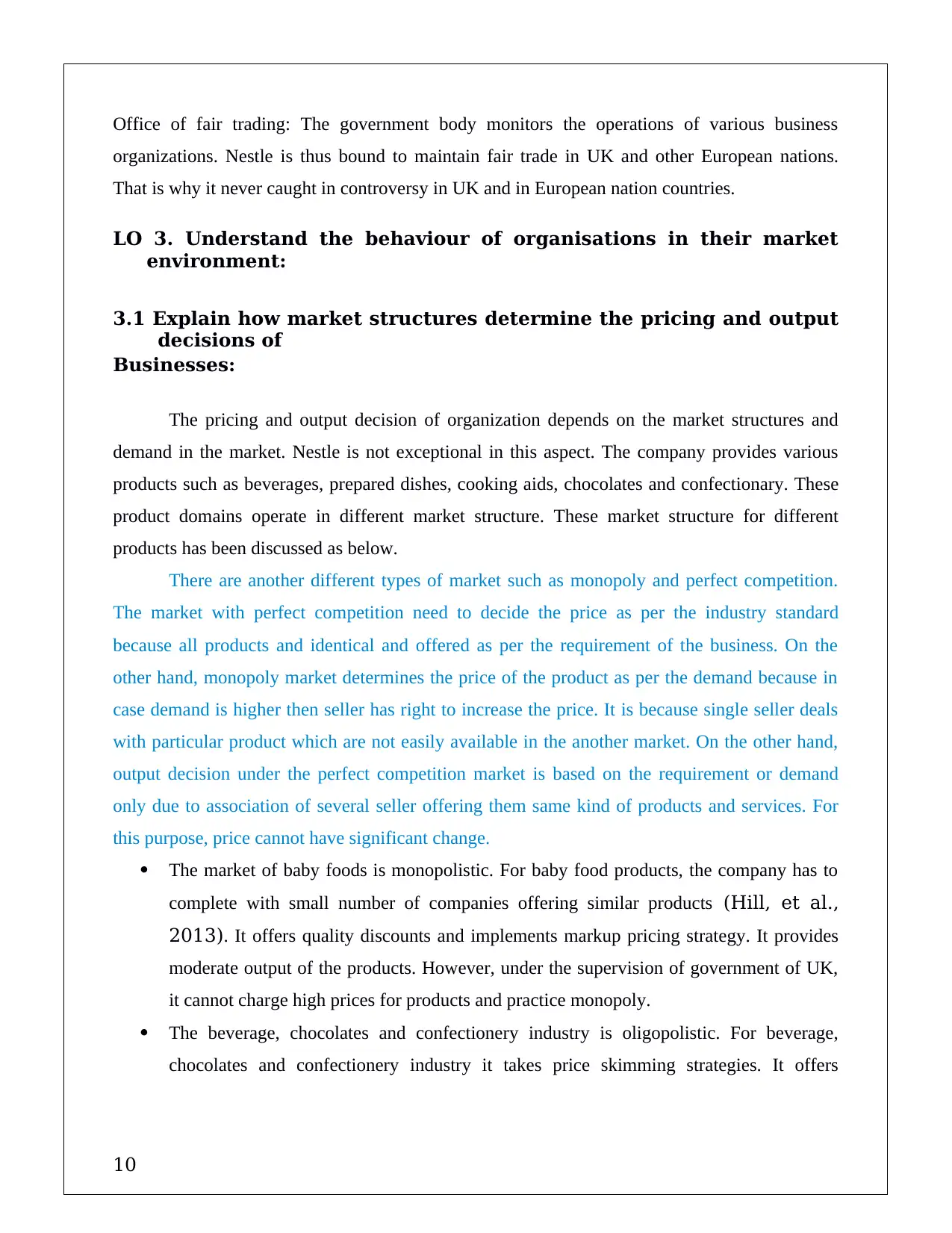
Office of fair trading: The government body monitors the operations of various business
organizations. Nestle is thus bound to maintain fair trade in UK and other European nations.
That is why it never caught in controversy in UK and in European nation countries.
LO 3. Understand the behaviour of organisations in their market
environment:
3.1 Explain how market structures determine the pricing and output
decisions of
Businesses:
The pricing and output decision of organization depends on the market structures and
demand in the market. Nestle is not exceptional in this aspect. The company provides various
products such as beverages, prepared dishes, cooking aids, chocolates and confectionary. These
product domains operate in different market structure. These market structure for different
products has been discussed as below.
There are another different types of market such as monopoly and perfect competition.
The market with perfect competition need to decide the price as per the industry standard
because all products and identical and offered as per the requirement of the business. On the
other hand, monopoly market determines the price of the product as per the demand because in
case demand is higher then seller has right to increase the price. It is because single seller deals
with particular product which are not easily available in the another market. On the other hand,
output decision under the perfect competition market is based on the requirement or demand
only due to association of several seller offering them same kind of products and services. For
this purpose, price cannot have significant change.
The market of baby foods is monopolistic. For baby food products, the company has to
complete with small number of companies offering similar products (Hill, et al.,
2013). It offers quality discounts and implements markup pricing strategy. It provides
moderate output of the products. However, under the supervision of government of UK,
it cannot charge high prices for products and practice monopoly.
The beverage, chocolates and confectionery industry is oligopolistic. For beverage,
chocolates and confectionery industry it takes price skimming strategies. It offers
10
organizations. Nestle is thus bound to maintain fair trade in UK and other European nations.
That is why it never caught in controversy in UK and in European nation countries.
LO 3. Understand the behaviour of organisations in their market
environment:
3.1 Explain how market structures determine the pricing and output
decisions of
Businesses:
The pricing and output decision of organization depends on the market structures and
demand in the market. Nestle is not exceptional in this aspect. The company provides various
products such as beverages, prepared dishes, cooking aids, chocolates and confectionary. These
product domains operate in different market structure. These market structure for different
products has been discussed as below.
There are another different types of market such as monopoly and perfect competition.
The market with perfect competition need to decide the price as per the industry standard
because all products and identical and offered as per the requirement of the business. On the
other hand, monopoly market determines the price of the product as per the demand because in
case demand is higher then seller has right to increase the price. It is because single seller deals
with particular product which are not easily available in the another market. On the other hand,
output decision under the perfect competition market is based on the requirement or demand
only due to association of several seller offering them same kind of products and services. For
this purpose, price cannot have significant change.
The market of baby foods is monopolistic. For baby food products, the company has to
complete with small number of companies offering similar products (Hill, et al.,
2013). It offers quality discounts and implements markup pricing strategy. It provides
moderate output of the products. However, under the supervision of government of UK,
it cannot charge high prices for products and practice monopoly.
The beverage, chocolates and confectionery industry is oligopolistic. For beverage,
chocolates and confectionery industry it takes price skimming strategies. It offers
10
Paraphrase This Document
Need a fresh take? Get an instant paraphrase of this document with our AI Paraphraser
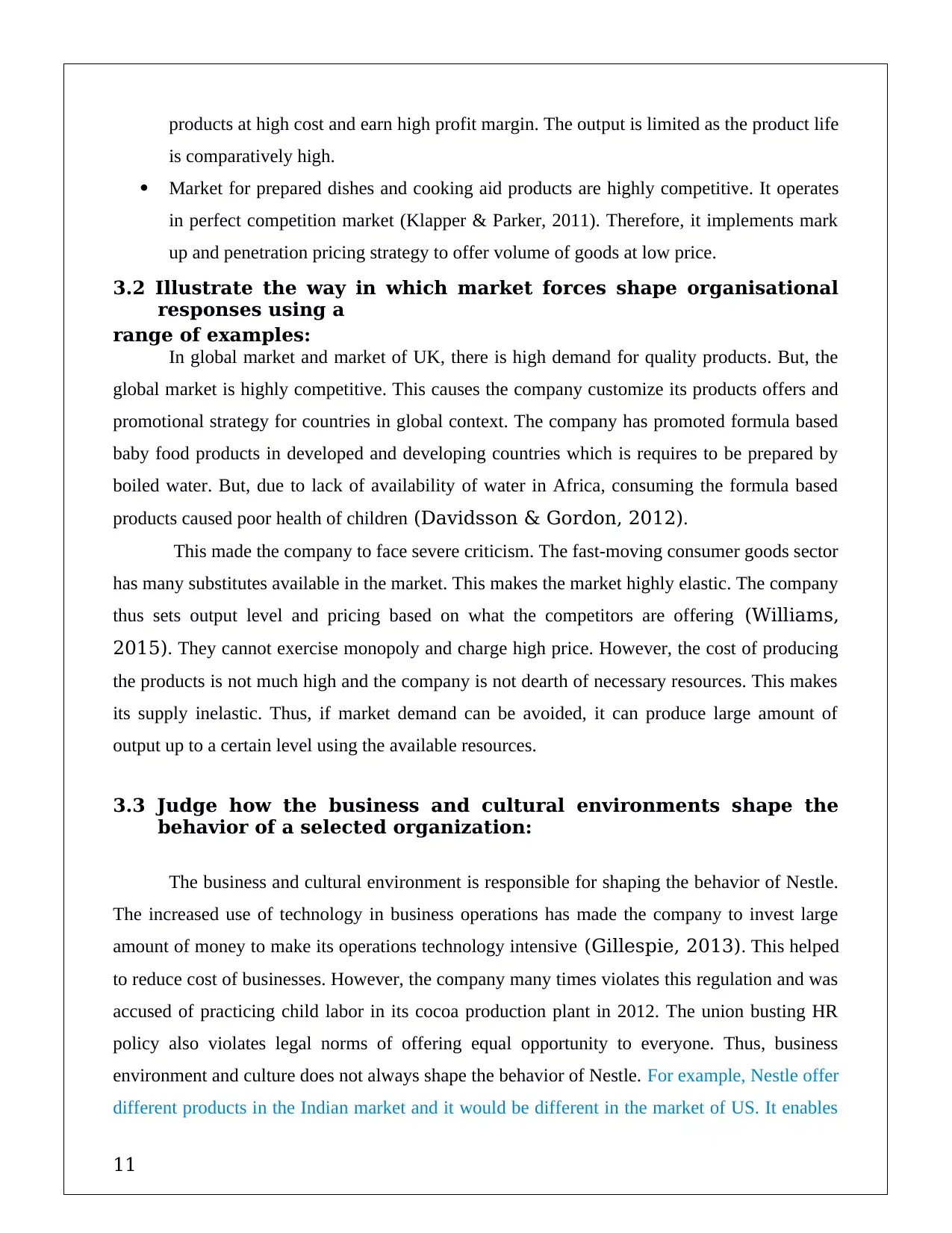
products at high cost and earn high profit margin. The output is limited as the product life
is comparatively high.
Market for prepared dishes and cooking aid products are highly competitive. It operates
in perfect competition market (Klapper & Parker, 2011). Therefore, it implements mark
up and penetration pricing strategy to offer volume of goods at low price.
3.2 Illustrate the way in which market forces shape organisational
responses using a
range of examples:
In global market and market of UK, there is high demand for quality products. But, the
global market is highly competitive. This causes the company customize its products offers and
promotional strategy for countries in global context. The company has promoted formula based
baby food products in developed and developing countries which is requires to be prepared by
boiled water. But, due to lack of availability of water in Africa, consuming the formula based
products caused poor health of children (Davidsson & Gordon, 2012).
This made the company to face severe criticism. The fast-moving consumer goods sector
has many substitutes available in the market. This makes the market highly elastic. The company
thus sets output level and pricing based on what the competitors are offering (Williams,
2015). They cannot exercise monopoly and charge high price. However, the cost of producing
the products is not much high and the company is not dearth of necessary resources. This makes
its supply inelastic. Thus, if market demand can be avoided, it can produce large amount of
output up to a certain level using the available resources.
3.3 Judge how the business and cultural environments shape the
behavior of a selected organization:
The business and cultural environment is responsible for shaping the behavior of Nestle.
The increased use of technology in business operations has made the company to invest large
amount of money to make its operations technology intensive (Gillespie, 2013). This helped
to reduce cost of businesses. However, the company many times violates this regulation and was
accused of practicing child labor in its cocoa production plant in 2012. The union busting HR
policy also violates legal norms of offering equal opportunity to everyone. Thus, business
environment and culture does not always shape the behavior of Nestle. For example, Nestle offer
different products in the Indian market and it would be different in the market of US. It enables
11
is comparatively high.
Market for prepared dishes and cooking aid products are highly competitive. It operates
in perfect competition market (Klapper & Parker, 2011). Therefore, it implements mark
up and penetration pricing strategy to offer volume of goods at low price.
3.2 Illustrate the way in which market forces shape organisational
responses using a
range of examples:
In global market and market of UK, there is high demand for quality products. But, the
global market is highly competitive. This causes the company customize its products offers and
promotional strategy for countries in global context. The company has promoted formula based
baby food products in developed and developing countries which is requires to be prepared by
boiled water. But, due to lack of availability of water in Africa, consuming the formula based
products caused poor health of children (Davidsson & Gordon, 2012).
This made the company to face severe criticism. The fast-moving consumer goods sector
has many substitutes available in the market. This makes the market highly elastic. The company
thus sets output level and pricing based on what the competitors are offering (Williams,
2015). They cannot exercise monopoly and charge high price. However, the cost of producing
the products is not much high and the company is not dearth of necessary resources. This makes
its supply inelastic. Thus, if market demand can be avoided, it can produce large amount of
output up to a certain level using the available resources.
3.3 Judge how the business and cultural environments shape the
behavior of a selected organization:
The business and cultural environment is responsible for shaping the behavior of Nestle.
The increased use of technology in business operations has made the company to invest large
amount of money to make its operations technology intensive (Gillespie, 2013). This helped
to reduce cost of businesses. However, the company many times violates this regulation and was
accused of practicing child labor in its cocoa production plant in 2012. The union busting HR
policy also violates legal norms of offering equal opportunity to everyone. Thus, business
environment and culture does not always shape the behavior of Nestle. For example, Nestle offer
different products in the Indian market and it would be different in the market of US. It enables
11
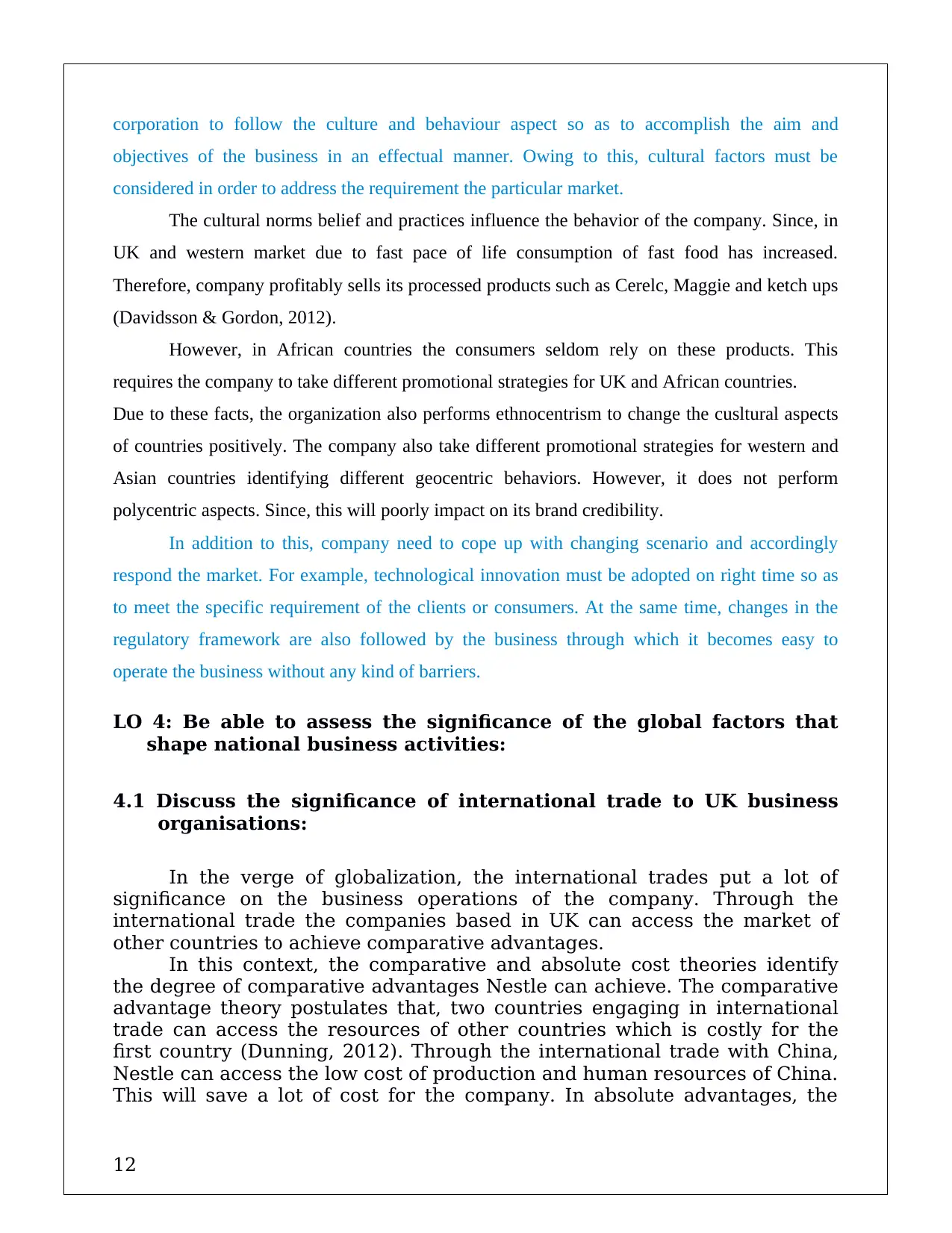
corporation to follow the culture and behaviour aspect so as to accomplish the aim and
objectives of the business in an effectual manner. Owing to this, cultural factors must be
considered in order to address the requirement the particular market.
The cultural norms belief and practices influence the behavior of the company. Since, in
UK and western market due to fast pace of life consumption of fast food has increased.
Therefore, company profitably sells its processed products such as Cerelc, Maggie and ketch ups
(Davidsson & Gordon, 2012).
However, in African countries the consumers seldom rely on these products. This
requires the company to take different promotional strategies for UK and African countries.
Due to these facts, the organization also performs ethnocentrism to change the cusltural aspects
of countries positively. The company also take different promotional strategies for western and
Asian countries identifying different geocentric behaviors. However, it does not perform
polycentric aspects. Since, this will poorly impact on its brand credibility.
In addition to this, company need to cope up with changing scenario and accordingly
respond the market. For example, technological innovation must be adopted on right time so as
to meet the specific requirement of the clients or consumers. At the same time, changes in the
regulatory framework are also followed by the business through which it becomes easy to
operate the business without any kind of barriers.
LO 4: Be able to assess the significance of the global factors that
shape national business activities:
4.1 Discuss the significance of international trade to UK business
organisations:
In the verge of globalization, the international trades put a lot of
significance on the business operations of the company. Through the
international trade the companies based in UK can access the market of
other countries to achieve comparative advantages.
In this context, the comparative and absolute cost theories identify
the degree of comparative advantages Nestle can achieve. The comparative
advantage theory postulates that, two countries engaging in international
trade can access the resources of other countries which is costly for the
first country (Dunning, 2012). Through the international trade with China,
Nestle can access the low cost of production and human resources of China.
This will save a lot of cost for the company. In absolute advantages, the
12
objectives of the business in an effectual manner. Owing to this, cultural factors must be
considered in order to address the requirement the particular market.
The cultural norms belief and practices influence the behavior of the company. Since, in
UK and western market due to fast pace of life consumption of fast food has increased.
Therefore, company profitably sells its processed products such as Cerelc, Maggie and ketch ups
(Davidsson & Gordon, 2012).
However, in African countries the consumers seldom rely on these products. This
requires the company to take different promotional strategies for UK and African countries.
Due to these facts, the organization also performs ethnocentrism to change the cusltural aspects
of countries positively. The company also take different promotional strategies for western and
Asian countries identifying different geocentric behaviors. However, it does not perform
polycentric aspects. Since, this will poorly impact on its brand credibility.
In addition to this, company need to cope up with changing scenario and accordingly
respond the market. For example, technological innovation must be adopted on right time so as
to meet the specific requirement of the clients or consumers. At the same time, changes in the
regulatory framework are also followed by the business through which it becomes easy to
operate the business without any kind of barriers.
LO 4: Be able to assess the significance of the global factors that
shape national business activities:
4.1 Discuss the significance of international trade to UK business
organisations:
In the verge of globalization, the international trades put a lot of
significance on the business operations of the company. Through the
international trade the companies based in UK can access the market of
other countries to achieve comparative advantages.
In this context, the comparative and absolute cost theories identify
the degree of comparative advantages Nestle can achieve. The comparative
advantage theory postulates that, two countries engaging in international
trade can access the resources of other countries which is costly for the
first country (Dunning, 2012). Through the international trade with China,
Nestle can access the low cost of production and human resources of China.
This will save a lot of cost for the company. In absolute advantages, the
12
⊘ This is a preview!⊘
Do you want full access?
Subscribe today to unlock all pages.

Trusted by 1+ million students worldwide
1 out of 16
Related Documents
Your All-in-One AI-Powered Toolkit for Academic Success.
+13062052269
info@desklib.com
Available 24*7 on WhatsApp / Email
![[object Object]](/_next/static/media/star-bottom.7253800d.svg)
Unlock your academic potential
Copyright © 2020–2025 A2Z Services. All Rights Reserved. Developed and managed by ZUCOL.





